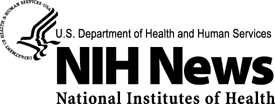 |
|
|
FOR IMMEDIATE RELEASE:
Monday, April 14, 2008 14 Apr 2008: Brain Study May Lead to Improved Epilepsy TreatmentsA Brain Study May Lead to Improved Epilepsy Treatments

Speaker: David S. Miller, Ph.D. Principal Investigator Laboratory of Pharmacology, NIEHS Using a rodent model of epilepsy, researchers found one of the body's own neurotransmitters released during seizures, glutamate, turns on a signaling pathway in the brain that increases production of a protein that could reduce medication entry into the brain. Researchers say this may explain why approximately 30 percent of patients with epilepsy do not respond to antiepileptic medications. The study, conducted by researchers at the National Institute of Environmental Health Sciences (NIEHS), part of the National Institutes of Health, and the University of Minnesota College of Pharmacy and Medical School, in collaboration with Heidrun Potschka's laboratory at Ludwig-Maximilians-University in Munich, Germany, is available online and will appear in the May 2008, issue of Molecular Pharmacology. "Our work identifies the mechanism by which seizures increase production of a drug transport protein in the blood brain barrier, known as P-glycoprotein, and suggests new therapeutic targets that could reduce resistance," said David Miller, Ph.D., a principal investigator in the NIEHS Laboratory of Pharmacology and co-author on the paper. The blood-brain barrier (BBB), which resides in brain capillaries, is a limiting factor in treatment of many central nervous system disorders. It is altered in epilepsy so that it no longer permits free passage of administered antiepileptic drugs into the brain. Miller explained that P-glycoprotein forms a functional barrier in the BBB that protects the brain by limiting access of foreign chemicals. "The problem is that the protein does not distinguish well between neurotoxicants and therapeutic drugs, so it can often be an obstacle to the treatment of a number of diseases, including brain cancer," Miller said. Increased levels of P-glycoprotein in the BBB has been suggested as one probable cause of drug resistance in epilepsy. Using isolated brain capillaries from mice and rats and an animal model of epilepsy, the researchers found that glutamate, a neurotransmitter released when neurons fire during seizures, turns on a signaling pathway that activates cyclooxygenase-2 (COX-2), causing increased synthesis of P-glycoprotein in these experiments. Increased transporter expression was abolished in COX-2 knockout mice or by COX-2 inhibitors. It has yet to be shown in animals or patients that targeting COX-2 will reduce seizure frequency or increase the effectiveness of anti-epileptic drugs. "These findings provide insight into one mechanism that underlies drug resistance in epilepsy and possibly other central nervous system disorders," said Bjoern Bauer, Ph.D., lead author on the publication. "Targeting blood-brain barrier signals that increase P-glycoprotein expression rather than the transporter itself suggests a promising way to improve the effectiveness of drugs that are used to treat epilepsy, though more research is needed before new therapies can be developed." Reference: ### The National Toxicology Program is an interagency program established in 1978 by the Secretary of Health, Education and Welfare, which today is known as the U.S. Department of Health and Human Services. The program was created as a cooperative effort to coordinate toxicology testing programs within the federal government, strengthen the science base in toxicology, develop and validate improved testing methods, and provide information about potentially toxic chemicals to health, regulatory, and research agencies, scientific and medical communities, and the public. The NTP is headquartered at the NIEHS, for additional information visit http://ntp.niehs.nih.gov/. The primary mission of the National Institute of Environmental Health Sciences (http://www.niehs.nih.gov/)(NIEHS), one of 27 Institutes and Centers at the National Institutes of Health, is to reduce the burden of human illness and disability by understanding how the environment influences the development and progression of human disease. For additional information, visit the NIEHS Web site at http://www.niehs.nih.gov/. The National Institutes of Health (NIH) - The Nation’s Medical Research Agency - includes 27 Institutes and Centers and is a component of the U. S. Department of Health and Human Services. It is the primary federal agency for conducting and supporting basic, clinical, and translational medical research, and it investigates the causes, treatments, and cures for both common and rare diseases. For more information about NIH and its programs, visit http://www.nih.gov/ |
|


